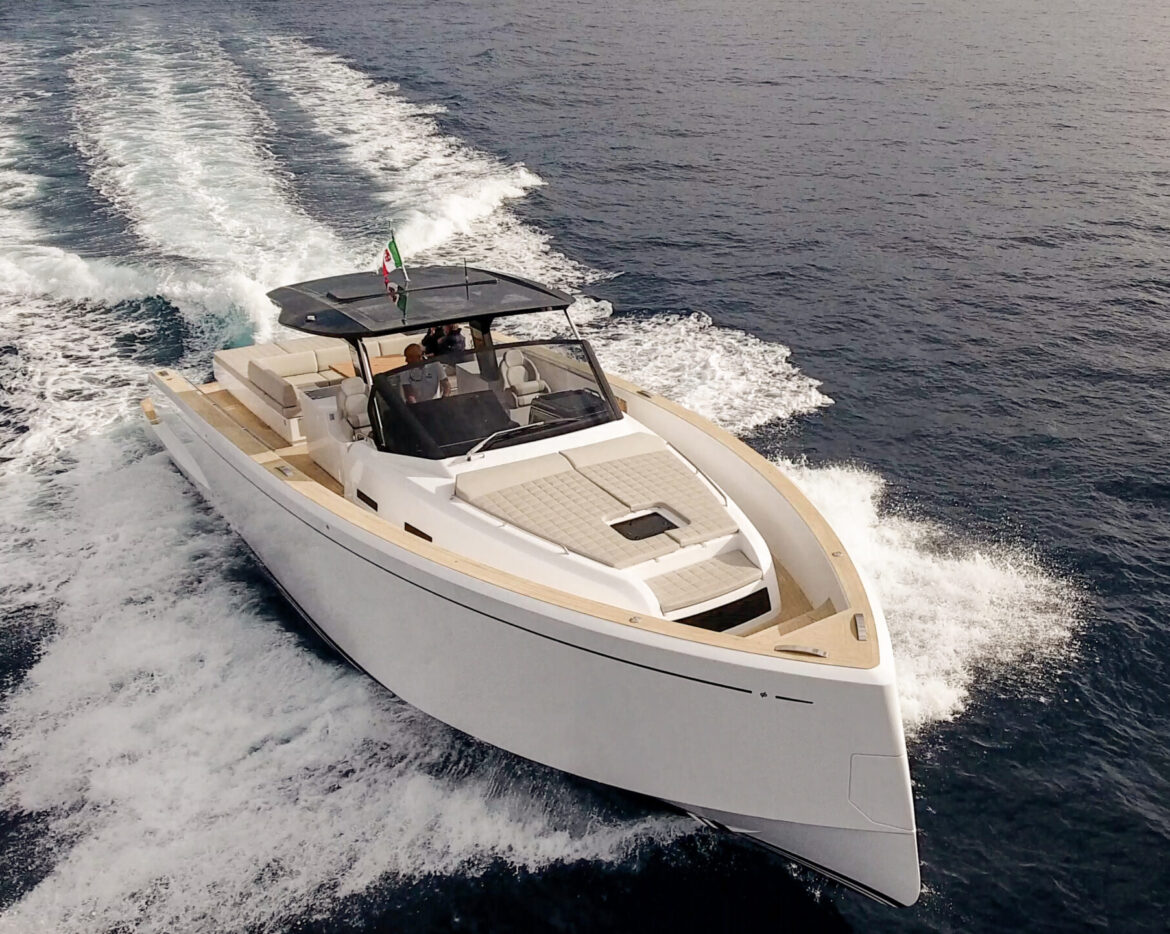LA DOLCE VITA
First impressions often set the tone in many walks of life, so when my eyes fell upon this first Pardo 50 to reach Australia at the Sydney Boat Show on the Eyachts pontoon, it definitely got my attention. A towering hull with a plumb bow and vast aft deck, I imagined myself back at my favourite Italian lake – Lago di Garda – where many graceful powerboats dart around. However, the Pardo 50 has more muscle than merely a lake boat, being rated at CE Cat A (Ocean), so it was a fitting idea to take it for a blast on Sydney’s answer to those Italian lakes: Pittwater.
Casting off from the dock at Quay’s Marina, company owner Peter Hrones gave me the helm while talking about this north Italian brand. “We find the quality is really good and the attention to detail fabulous”. Peter should know, given this is the tenth hull of the brand to reach Australia. Ranging in size from 38 to 75 feet and available in various topside configurations, the Pardo 50 is the mid-range model. The T-Top version with open cockpit is, I think, ideal for most Australian conditions; but for more temperate waterways the fully enclosed GT52 model might be the go. These two or three cabin boats have the deck space, performance and overnight capabilities to have wide appeal; based on heavily chined hulls intended to deal with offshore conditions.

This first Australian hull, number 206, shows the popularity of the model, which is clearly aimed at the premium end of the market, where it could be a standalone vessel or superyacht tender. However, its ability to sleep four guests plus a crew berth (or two kids’ bunks there) means it’s a versatile boat, as I found when spending a morning on it. Stepping on the aft transom, the first point of interest is the dinghy garage that opens to reveal a Williams 280 jet tender, with more space for offshore essentials such as a life raft. I’ve had some high-speed and scary drives on these British made Rotax powered Williams but they are fun and of course safer because there’s no propeller. It slides out via rollers onto the large teak swim platform.
Stepping up to the aft cockpit, the wide beam creates a vast sunpad in front of an equally large U-shaped lounge. It’s clad in tough Silvertex with a locally finished hardwood table in the centre that folds out. It’s lovely varnish work will require covering from the harsh sunlight but the overhead extending sunshade is ideal for al fresco dining. There’s dual fridges plus extensive wet bar facilities beside it, all under the carbon T-Top to give lots of catering options, including a sensibly deep sink. Also here on the portside is another hatch cover with ladder leading down into the small crew cabin. It has basic ablutions, along with single bunk; alternatively its bulkhead could be removed to create a larger stern guest cabin that holds three single beds.
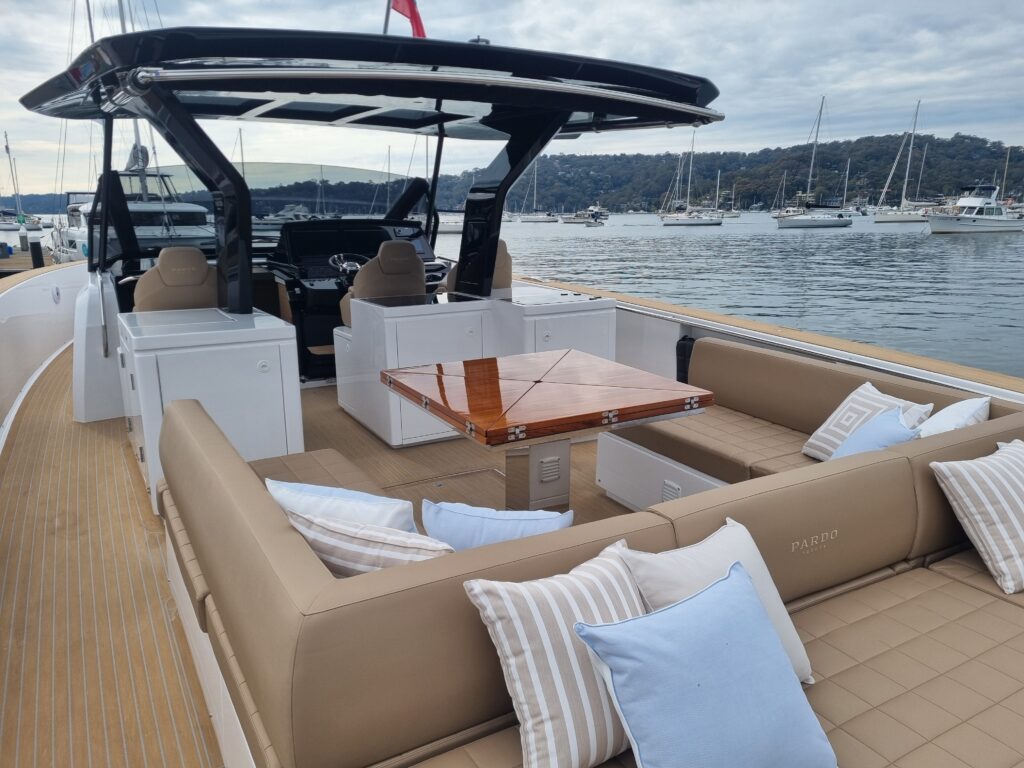
I move forward to the console, with UV-resistant Flexiteek under my deck shoes to lean on the dual bucket, and bolster seats. They are well-shaded under the prow of the carbon T-Top with a large frameless spray window out front. This steering position gives the best of both worlds – protection, yet with the feel of a sports boat. The premium level fit-out means there are dual 16-inch Garmin navigation screens here, along with a Volvo engine screen for the two 425HP pod drives, along with an obligatory joystick for easy close manoeuvring. Good ergonomics include two sturdy 316 stainless handrails on the console, which match those on the deck bulwarks. The centre console design allows me to dart out to the deck and amble to the foredeck, easily and safely done within the waist-high bulwarks. This is relaxation central with elongated sunbed and more of those sturdy handrails. At the bow, the recessed seat is also the cover for the deep chain locker with vertical Quick windlass that deploys the anchor from within the hull via a bow hatch at the stemhead. Neat and of course safe because there’s nothing sharp to bump other boats or people. But perhaps a bow ladder would also be handy. Other quality finishes include the recessed and oversized cleating all round; and even recessed steps in the bulwarks to aid boarding from higher quaysides.
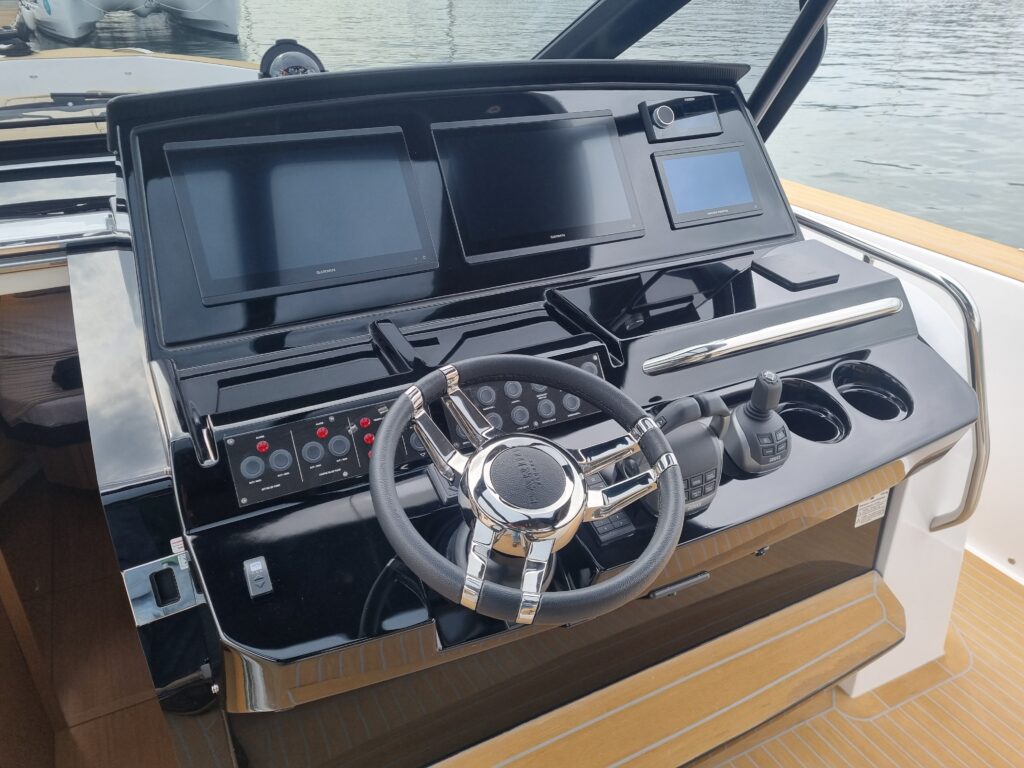
BELOW DECKS
Steps beside the steering console, with a sliding tinted glass door, lead me down into the main cabin. Here, there’s a large (1.6mx2.0m) island berth in the bow, and it is spacious, with about seven feet of headroom, falling to 6’2 over the master bed in the V-berth thanks to the deep bow section of the Pardo 50. Two opening side windows and a sealed one forward, plus a skylight, mean this there is cool respite when you choose not to click on the aircon. The light oak finish adds to this airiness with lots of it, used for cupboards, including a stylish glass rack in one. But the entire area is unfussy, so easily maintained, and very much Euro-Chic in its minimalist approach, which gets my vote. Equally spacious is the bathroom on portside, which stretches aft to include a large shower cubicle. Other basics include the electric head with a sensibly sized Corian sink with vanity. Again, an opening hatch allows air in. Moving aft to the guest cabin with its twin beds. Here, the ceiling is lower because of the cockpit sole, but a deep well between the bed gives added headroom, but there are no portlights, so it’s a wee bit claustrophobic for those unused to maritime sleeping, perhaps. But it does have an ensuite toilet with sink, so a handy weekend berth.


PITTWATER SOJOURN
Speeding past Scotland Island on the glassy waters of Pittwater I was again reminded of the stunning landscapes and seascapes that we live among in Sydney. Ahead, the snub-nosed profile of Lion Island could be clearly seen because the neutral trim of the Pardo 50 gave me clear views. Looking down at the Garmin, it showed 30 knots, so we were really moving and, in my view, officially at sports boat speed; being 30 knots. Yet there was more available when I pushed the electronic throttles fully down, which pushed the Pardo 50 to ease up to 34 knots. Seeking a bump or two I turned the wheel to put us into some tight turns and then a figure of eight which created enough wash to hear none came. Easing back to a more sedate (and economical) cruising speed of 29 knots with only 20% tabs felt very much in the groove for the Pardo 50; giving a reasonable range of 322nm. Behind the screen, the ride was sheltered but thrilling, and visibility was good all around, especially handy when we spotted a bunch of kayakers up ahead, which prompted me to turn into Little Mackerel Beach.
Here, I clicked the joystick to precisely and easily go astern towards the beach, before spinning round and coming to a halt. Ideally, I’d then click another button to release the anchor for an overnight sojourn to enjoy more of la dolce vita that this slick Pardo 50 clearly offers.
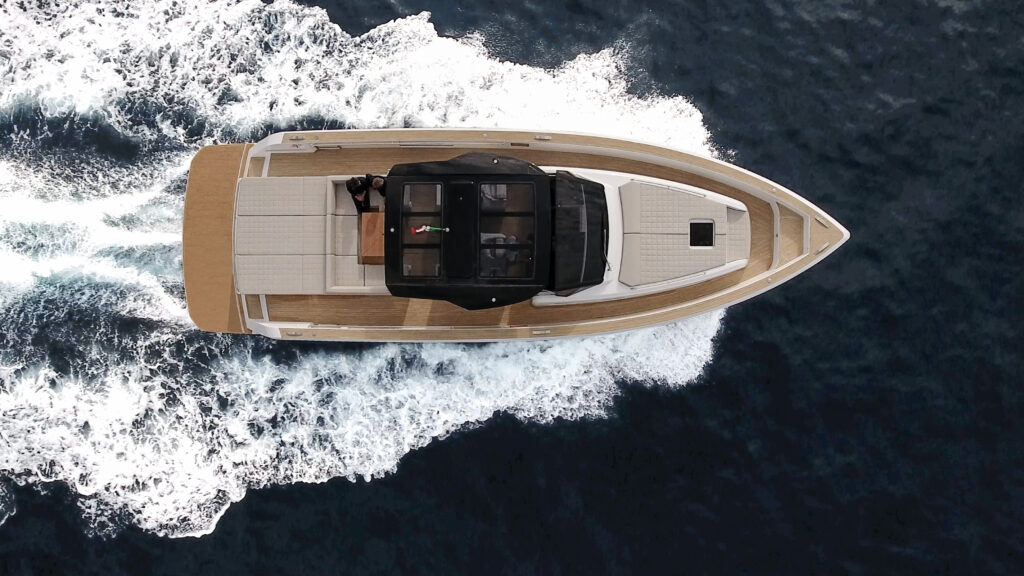
HULL AND SYSTEMS
The hull is infused with monolithic parts such as the keel, chines and engine grid, with the rest in foam sandwich for lightness; The deck is moulded in highdensity PVC for rigidity and thermal/acoustic insulation. Composite structural bulkheads segregate the engine room and are also beneath the console area. The engine room is accessed from the aft cockpit sole, with a tall ladder required to descend into the deep hull. The dinghy garage impinges on the twin Volvo 425HP units but thanks to sunken footplates in the deep bilges, there’s plenty of room for me to investigate the transom section. Here is a remarkable find – jack shafts used to connect the IPS pod drives. This immensely improves the trim by putting the engines much further forward into the hull. That indeed was my experience underway, with little need for the Volvo Interceptor trim tabs. Engine options are IPS 700 (2 x 550HP) or IPS 800 (2 x 600HP) and there’s even a space for a gyro stabiliser for those prone to mal de mer. In the engine room, there are five KVA Kohler generators onboard and twin-wing fuel tanks. Again, all this weight is nearly midships longitudinally to improve trim. Other notable features I liked were the use of sight gauges on the stainless steel fuel tanks (should the electronics gauges fail) and quality bronze seacocks throughout. Also, all the switchboards were high up on the bulkheads to avoid water; plus, thick soundproofing clearly worked as my helm time was more about wind noise than engine noise.
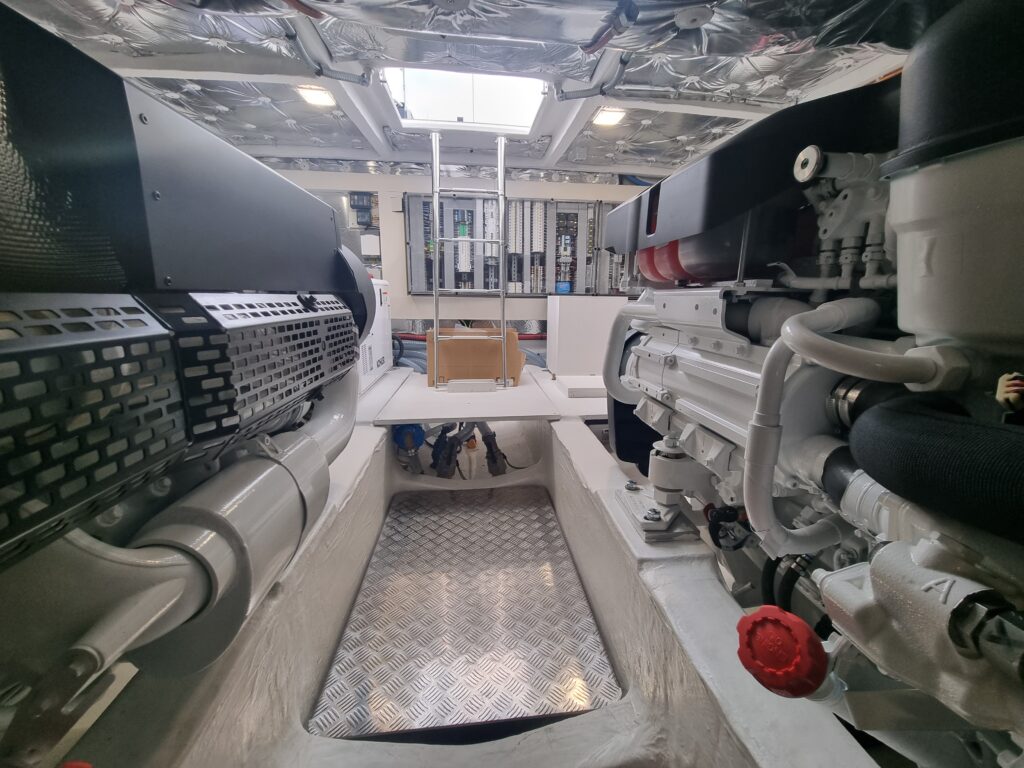
SPECIFICATIONS
Length Overall 16.25m
Hull Length 14.95m
Beam 4.96m
Draft 1.23m
Persons 12 A / 16 B / 20 C
Displacement 14.9 Ton
Engines 2 x Volvo IPS 600 (2 x 435 HP) or 550HP/600HP
Fuel Capacity 2,000L
Water 450L
Design Zuccheri Yacht Design & Cantiere del Pardo
Builder Cantiere del Pardo
Cabins 2 plus skipper option
PERFORMANCE DATA
RPM KNOTS L/h L/nm
1000 8.1 16 1012
1500 11 52 423
2000 16 100 320
2500 25.2 160 315
2780 29.5 183 322
3010 34 248 274



